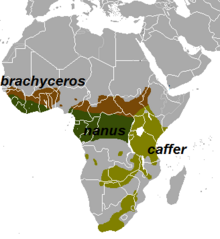
Back Buffel Afrikaans ጎሽ Amharic جاموس إفريقي Arabic جاموس افريقى ARZ Syncerus caffer AST Африкаялъул гамущ AV Ayadukol (Syncerus caffer) AVK Adi Afrika kəli Azerbaijani Буйвал афрыканскі Byelorussian Буйвал афрыканскі BE-X-OLD
| African buffalo Temporal range: Middle Pleistocene-Holocene
| |
|---|---|

| |
| Cape buffalo (S. c. caffer) at Chobe National Park, Botswana with a Cattle egret atop it | |

| |
| Forest buffalo (S. c. nanus) at Réserve Africaine de Sigean, France | |
| Scientific classification | |
| Domain: | Eukaryota |
| Kingdom: | Animalia |
| Phylum: | Chordata |
| Class: | Mammalia |
| Order: | Artiodactyla |
| Family: | Bovidae |
| Subfamily: | Bovinae |
| Genus: | Syncerus |
| Species: | S. caffer
|
| Binomial name | |
| Syncerus caffer (Sparrman, 1779)
| |
| Subspecies | |
|
S. c. caffer | |

| |
| Range of the commonly accepted forms of the African buffalo | |


The African buffalo (Syncerus caffer) is a large sub-Saharan African bovine.[2] There are five subspecies that are recognized as being valid. Syncerus caffer caffer, the Cape buffalo, is the nominotypical subspecies, and the largest one, found in Southern Africa and East Africa. S. c. nanus (the forest buffalo) is the smallest subspecies, common in forest areas of Central Africa and West Africa, while S. c. brachyceros is in West Africa and S. c. aequinoctialis is in the savannas of East Africa. The adult African buffalo's horns are its characteristic feature: they have fused bases, forming a continuous bone shield across the top of the head, referred to as a "boss".
The African buffalo is more closely related to other buffalo species than it is to other bovids such as American bison or domestic cattle, with its closest living relative being the Asian water buffalo.[3] Its unpredictable temperament may be part of the reason that the African buffalo has never been domesticated, which would also explain why the African buffalo has no domesticated descendants, unlike the wild yak which is an ancestor of the domestic yak. Natural predators of adult African buffaloes include lions, African wild dogs, spotted hyenas, and Nile crocodiles. As one of the Big Five game animals, the Cape buffalo is a sought-after trophy in hunting.
- ^ IUCN SSC Antelope Specialist Group (2019). "Syncerus caffer". IUCN Red List of Threatened Species. 2019: e.T21251A50195031. doi:10.2305/IUCN.UK.2019-1.RLTS.T21251A50195031.en. Retrieved 19 November 2021.
- ^ Grubb, P. (2005). "Order Artiodactyla". In Wilson, D.E.; Reeder, D.M (eds.). Mammal Species of the World: A Taxonomic and Geographic Reference (3rd ed.). Johns Hopkins University Press. pp. 695–696. ISBN 978-0-8018-8221-0. OCLC 62265494.
- ^ Jirik, Kate. "LibGuides: Forest Buffalo (Syncerus caffer nanus) Fact Sheet: Taxonomy & History". ielc.libguides.com. Retrieved 2023-04-30.
© MMXXIII Rich X Search. We shall prevail. All rights reserved. Rich X Search
